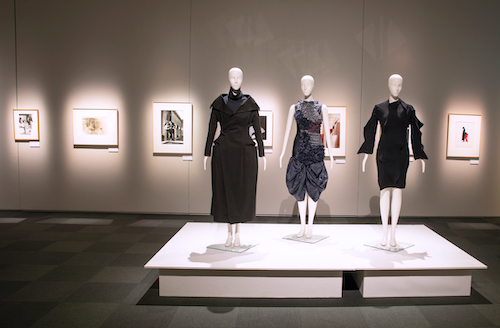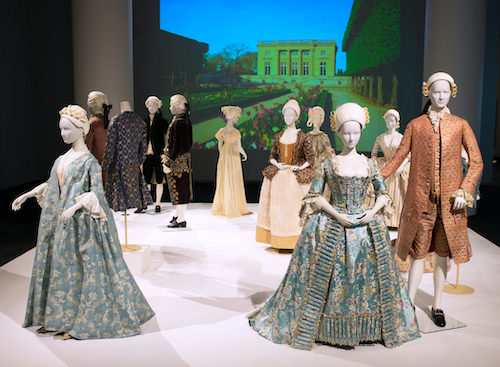Treasures of Fashion ― the aesthetic sense of Valerie Steele
Dr. Valerie Steele guest curates a new exhibition at the Kobe Fashion Museum, Japan
Closes August 30, 2020.
Watch the 5-minute exhibition walkthrough narrated by Valerie!
To be a curator traditionally meant to be the keeper or caretaker of the collection of a museum or archive. Safeguarding a heritage is still important. But today the word "curator" increasingly refers to the person who organizes exhibitions, choosing and arranging objects in such a way as to interpret the work for the education and inspiration of the public. In some respects, a curator is like a professor - an expert in the subject area of the collection, be it fashion or art. In other respects, a curator is more like a creative artist, whose medium is exhibition making.
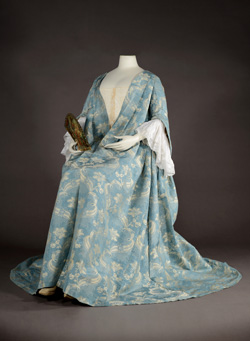 Last year, during my research visit to the Kobe Fashion Museum's collection, I not only reviewed the breadth of the collection, I also studied the museum's spatial
organization, which is divided into five galleries of varying sizes, some punctuated
by columns. The curators of the Kobe Fashion Museum typically organize a single large
exhibition, which fills all five galleries. However, as a guest curator, confronted
with the exciting richness of a "new" collection, I decided to organize several smaller
thematic exhibitions, which would allow me to explore different curatorial strategies.
Last year, during my research visit to the Kobe Fashion Museum's collection, I not only reviewed the breadth of the collection, I also studied the museum's spatial
organization, which is divided into five galleries of varying sizes, some punctuated
by columns. The curators of the Kobe Fashion Museum typically organize a single large
exhibition, which fills all five galleries. However, as a guest curator, confronted
with the exciting richness of a "new" collection, I decided to organize several smaller
thematic exhibitions, which would allow me to explore different curatorial strategies.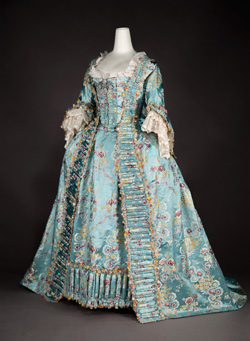
A lifelong Francophile, I immediately decided to devote the first gallery to a mini exhibition on eighteenth-century "Rococo" fashion, since Kobe's holdings from this important period in fashion history are outstanding. As dress historian Aileen Ribeiro writes: "The essence of eighteenth-century costume is the sophisticated urban dress - embroidered velvet coat and knee breeches, rustling silk taffeta dress over paniers, powdered hairstyles - that was France's great contribution to the world of fashion and civilized living."
The collection of the Kobe Fashion Museum permits visitors to trace the development of eighteenth-century fashion from a rare robe volante (c. 1730) to the robe a la française, the century's quintessential feminine aristocratic style, an open gown worn over paniers and stays, displaying a decorative stomacher and petticoat, and typically with Watteau pleats down the back.
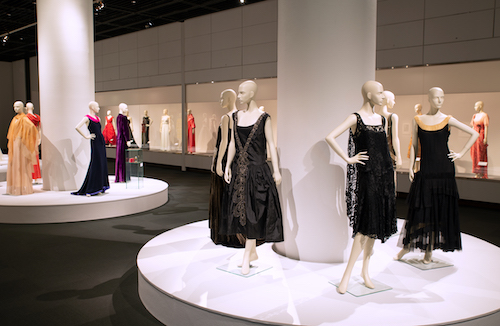
If the first gallery focuses on the "Rococo," the second gallery is devoted to the most famous and influential fashion designer of the twentieth century, Gabrielle "Coco" Chanel. However, whereas most exhibitions on Chanel look at her in isolation, my mini exhibition "Chanel and Her Rivals" puts her into context with her great contemporaries. Part 1 of "Chanel and Her Rivals" features work by Chanel along with that of designers such as Madeleine Vionnet, Jeanne Lanvin, and Elsa Schiaparelli who were among Chanel's female rivals from the early twentieth century until 1939.
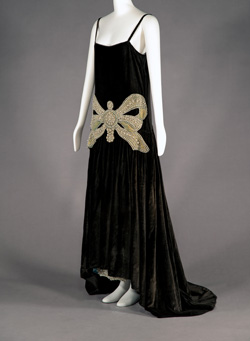
Jeanne Lanvin, 1924, KFM.
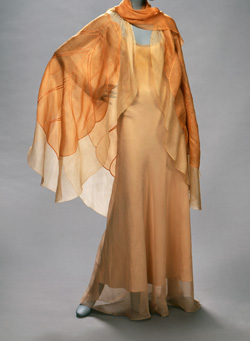
Madeleine Vionnet, c.1933, KFM.
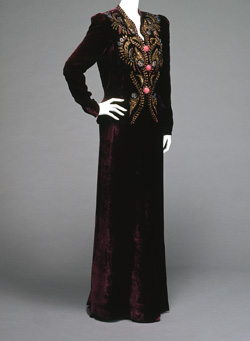
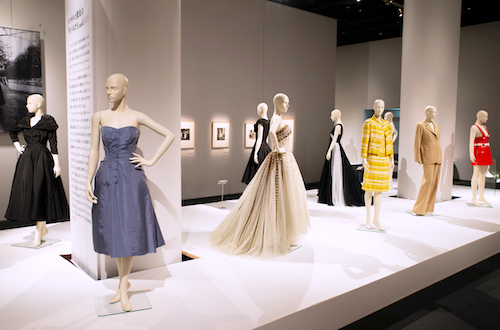 Part II of "Chanel and Her Rivals" looks at the post war situation, when Chanel’s
competitors were primarily men like Christian Dior, Hubert Givenchy, and Cristóbal
Balenciaga. I hope to encourage curators to focus less on designer retrospectives
and more on comparisons between and among designers.
Part II of "Chanel and Her Rivals" looks at the post war situation, when Chanel’s
competitors were primarily men like Christian Dior, Hubert Givenchy, and Cristóbal
Balenciaga. I hope to encourage curators to focus less on designer retrospectives
and more on comparisons between and among designers.
Japanese dress exerted a profound influence on western fashion. This is a subject made familiar by exhibitions like Akiko Fukai's Japonisme in Fashion, organized by the Kyoto Costume Institute in 1996. However, it deserves to be looked at again in the context of Kobe's collection. "Japan and Western Fashion" focuses on western fashion dating from the 1880s to the 1920s, as well as kimono from the Edo and Taisho periods. In the late nineteenth century, European women wore dresses that were tightly fitted over corsets and bustles. By the 1910s and 1920s, however, they had adopted much looser clothing. There were many contributing factors to this transformation.
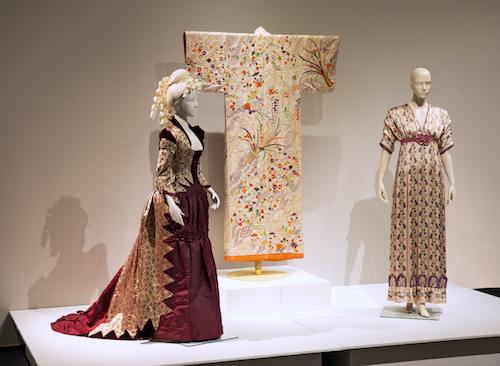
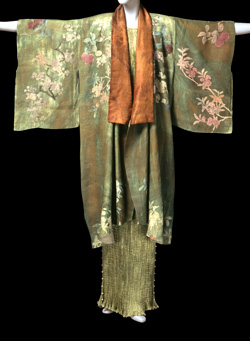 Women's growing independence played a role, especially during and after World War
I. Equally important was the development of a new ideal of feminine beauty. In the
1880s, the ideal woman was a voluptuous woman, resembling Venus or Juno. By 1907,
the ideal was shifting toward a slender, youthful, athletic Diana. The popularity
of Japanese art in Europe also played a role in creating this new aesthetic, as European
women experimented with wearing kimono, which looked and felt different than western
fashion. By the 1920s, the modern girl had become a familiar figure even in Japan.
Women's growing independence played a role, especially during and after World War
I. Equally important was the development of a new ideal of feminine beauty. In the
1880s, the ideal woman was a voluptuous woman, resembling Venus or Juno. By 1907,
the ideal was shifting toward a slender, youthful, athletic Diana. The popularity
of Japanese art in Europe also played a role in creating this new aesthetic, as European
women experimented with wearing kimono, which looked and felt different than western
fashion. By the 1920s, the modern girl had become a familiar figure even in Japan.
The fourth and fifth galleries comprise a final section entitled "Fashion: Image and Object," which is devoted primarily to fashion photography, of which the Kobe Fashion Museum has an outstanding collection spanning a century of iconic images. The fifth gallery also includes three fashion "objects": modern Japanese fashions by Issey Miyake, Yohji Yamamoto, and Rei Kawakubo of Comme des Garçons, whose work revolutionized global fashion in the late twentieth century.
~ Dr. Valerie Steele, The Museum at FIT
